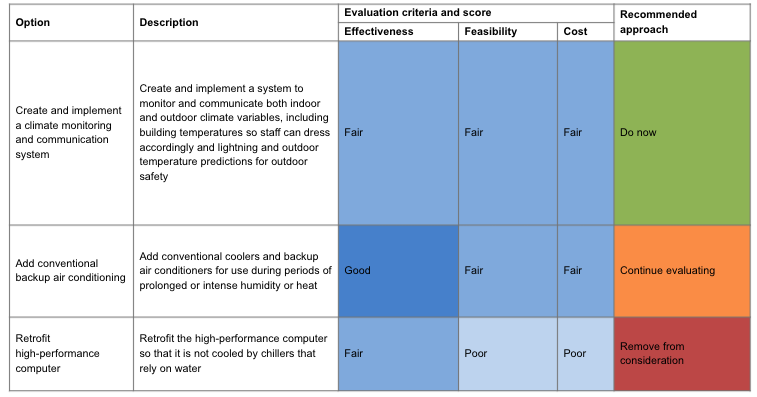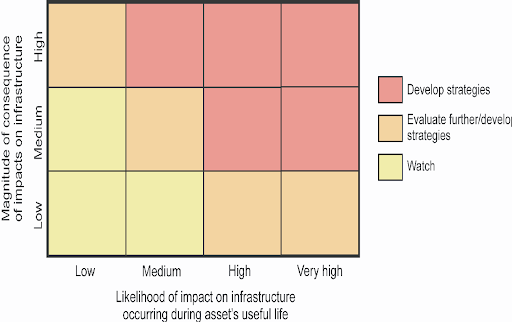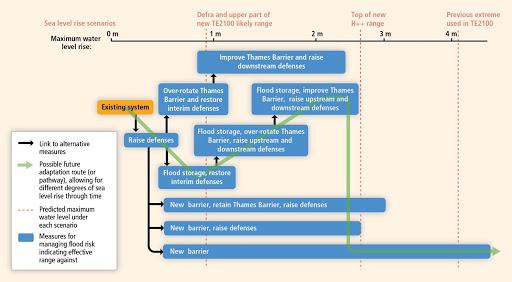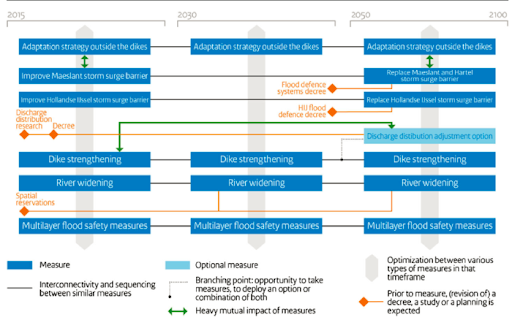Sections
Make decisions that work or function over a wide range of possible conditions. Aim for flexibility, robustness, and resilience.
-
Flexibility: The adaptation can accommodate different conditions by adjusting.
-
Robustness: The adaptation can withstand a variety of conditions.
-
Resilience: The adaptation can recover from shocks. In the context of climate change, resilience has been used to also include withstanding shocks.
-
Consider economics: benefits should exceed costs. It’s complicated when benefits (avoided impacts) may not happen or be much larger decades into the future.
-
Discounting—do not spend a lot now to avoid risks many years from now.
-
Incremental investments include low-cost adjustments to infrastructure. These can buy additional protection now and into the future.
- Consider the option of buying land on which you can build infrastructure in the future.
- Diversify your portfolio of options.
- Use resilient or flexible management systems.
- Recognize that water markets are responsive to changing conditions.
Traditional assessment approaches are often used to help identify an optimal solution. Deep uncertainty approaches recognize that “deep uncertainty” is part of the problem and try to identify adaptations that can work across an array of possible outcomes. Traditional approaches work best when uncertainties are well-characterized. However, since probabilities are not assigned, it’s hard to apply traditional approaches.
- Benefit-Cost Analysis (BCA)
- Expresses all benefits and costs in a common unit, typically money
- Seeks to maximize net benefits and benefit-cost ratio
- Cost-effectiveness
- Seeks the least costly and most feasible way to achieve a common outcome
- Multi-criteria assessment
- Typically applied where different metrics are used; useful when some metrics aren’t easy to compare
- Triple Bottom Line (TBL)
- Splits out financial, social, and environmental benefits
- Can be used along with the above approaches. Other methods often overlook social and environmental benefits, but TBL provides more than just finances.
The probabilities of outcomes are unknown. There are no reliable probabilities on greenhouse gas emissions. Regional climate change makes predicting the outcomes more challenging. Assessing risks over generations also requires an understanding of risks to life and property now and into the future. Assessments must look for the least expensive way to achieve a particular outcome. The objective must have the same quantifiable value and this can be difficult.
- The Environmental Protection Agency compared how much money spent per life saved from various environmental threats.
- $ per Disability Life Year (DALY)
- $ per unit of water supply
Assessments show whether money is being spent efficiently or where you would put your resources to most efficiently protect life.
Multi-Criteria Assessment (MCA) is useful for qualitatively comparing different attributes of options. The example compares options based on effectiveness, feasibility, and costs. Rather than using a common metric such as money, MCA uses ordinal ranking, such as high, medium and low or good, fair, and poor.
When developing a plan, it is important to compare the likelihood and consequence of the various outcomes, as displayed in the graphic below. In risk management it can make the most sense to avoid high likelihood and high consequence outcomes. It may also be desirable to try to avoid low likelihood, high consequence outcomes.
-
Recognizes that we can adjust decisions as conditions change
-
Design systems/decisions so that changes in future conditions can be incorporated
-
Option to use land for investment in future, such as a reservoir
-
Example: Thames River barrier was built to protect London from storm surges over the rest of the century. They’ve implemented an adaptive management system that allows them to make their next decisions based on future sea level rise.
The Thames River Metropolitan Water District organized near-term investments in local supplies expecting that some will need to expand and some will be contracted as demand, regulations, climate, and other factors change. The American Society for Civil Engineers recommends an adaptive management approach.
Adaptive management can also spread out decisions over time, as seen in the figure below, which shows decisions on flood risk in Rotterdam.
- No Regrets
- Adaptation can be justified without consideration of climate change.
- Greater benefits are expected with climate change.
- Example: Water conservation makes sense, but also provides greater benefits if you’re not sure about the availability of long-term supplies or increases in demand.
- Low Regrets
- Incorporates the risks of climate change.
- Typically involves making a small investment because of climate change in order to improve the system.
- “Low regret” on the cost side if it doesn’t work out.
- Incremental Adaptation
- Incrementally increases the size of the investment or make other incremental changes to adapt to expected climate change.
- Makes the most sense when the cost of incremental change is low.
- Appropriate for decisions with a long lifetime.
- Can be inappropriate if fundamental change is needed faster than incremental change.
Emphasis is on “support.” Tools do not tell you the “right” decision, but they can help organize complex information and provide insight on adaptation options. Tools can serve as a mechanism to bring stakeholders together to work through understanding risks and options so as to reduce conflict, identify key uncertainties, and suggest approaches or strategies that can work.
Many factors affect decisions. Many of those factors will change over time. The point is not to project these, but to understand how change in these and other factors can change vulnerability of a system to climate:
- Population
- Income
- Technology
- Preferences/Culture
Adaptations often incorporate ranges or are incremental.
- Example: Culverts can accommodate a wide range of water flow and come in incremental diameters from 6 inches to one foot.
- Decisions on sea level rise and flooding are often made in one-foot increments.




